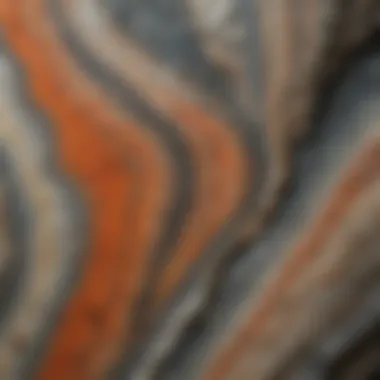Unveiling the Alluring Spectrum of Shale Colors in Geological Specimens


Rock and Fossil Identification
Shale, a sedimentary rock renowned for its stunning array of colors, presents a fascinating subject for rock and fossil collectors. To identify different shale specimens, it is crucial to understand the types of rocks and fossils associated with shale formations. Observing characteristics such as layering, texture, and fossil inclusions can provide valuable clues for identification. Utilizing tools like geologic hammers, hand lenses, and field guides can aid enthusiasts in effectively identifying and cataloging their shale samples.
Geological Insights
Delving deeper into the geological significance of shale colors unveils a wealth of fascinating information. Shale colors reflect the specific mineral compositions and environmental conditions during the rock's formation. Understanding the geological formations and processes that contribute to the diverse hues of shale can provide enthusiasts with a profound appreciation for the Earth's intricate history. Exploring the historical significance of rocks and fossils found in shale deposits can offer insights into past environments and evolutionary developments. Notable discoveries of rare or exceptionally preserved specimens in shale formations contribute to the rich tapestry of geological insights awaiting collectors.
Introduction to Shale Colors
Shale colors in geological specimens are a fascinating topic that provides valuable insights into the formation processes and mineral compositions of these rocks. Understanding the nuances of shale colors is essential for rock and fossil collectors to appreciate the intricate beauty and significance behind each hue. By delving into the world of shale colors, collectors can unravel the mysteries of geological history encapsulated in these vibrant and diverse specimens.
Understanding Shale Formation
Shale formation is a complex process influenced by various factors such as sedimentation, compaction, and organic matter deposition. The deposition of fine-grained particles over millions of years results in the compacted layers of shale we see today. By understanding the geological processes involved in shale formation, collectors can gain a deeper appreciation for the colors exhibited in these specimens and the environmental conditions that shaped them.
Factors Influencing Shale Colors
Shale colors are influenced by several key factors, each playing a crucial role in determining the hues and patterns observed in geological specimens. These factors include:
Impact of Organic Matter
Organic matter present during shale formation contributes significantly to the color variations seen in specimens. The type and concentration of organic material embedded in shale layers directly impact the colors displayed, ranging from earthy browns to vibrant greens. Collectors can trace the organic history of a region through the distinct colors generated by various organic compounds found in shale.
Mineral Content
The mineral composition of shale plays a vital role in determining its color palette. Different minerals present in shale layers impart specific hues, with iron oxides creating reds and yellows, while chlorite contributes to greens and blues. Understanding the mineralogical composition of shale is crucial for collectors to identify and categorize specimens based on their distinctive color signatures.
Environmental Conditions


Environmental conditions such as depositional settings, climate variations, and diagenetic processes leave lasting imprints on shale colors. Arid environments may produce distinct reddish hues due to iron oxidation, while marine sediments can exhibit a range of blues and grays influenced by sea-floor conditions. By considering the environmental context of shale deposition, collectors can unravel the geological narratives embedded in these colorful rock formations.
Significance of Shale Colors
The colors showcased in shale specimens hold immense significance beyond their aesthetic appeal, serving as essential indicators of geological history and environmental evolution. The key aspects highlighting the significance of shale colors include:
Indicators of Geological History
Shale colors serve as valuable indicators of past geological events and environmental conditions. By studying the color variations in shale layers, geologists can reconstruct ancient landscapes, climate patterns, and depositional environments. Each color layer in shale reflects a chapter in the Earth's history, allowing collectors to piece together the geological puzzle of bygone eras.
Use in Stratigraphic Analysis
Shale colors play a pivotal role in stratigraphic analysis, aiding geologists in correlating rock formations and identifying sedimentary sequences. The unique color patterns within shale layers help establish stratigraphic boundaries and interpret depositional processes, offering critical insights into the geological evolution of a region. Collectors can leverage shale colors as invaluable tools for stratigraphic interpretation and chronological determination.
Aesthetic Value for Collectors
Beyond their scientific significance, shale colors hold immense aesthetic value for collectors and enthusiasts. The kaleidoscope of colors found in shale specimens appeals to artistry and creativity, turning these geological formations into coveted collectibles. Collectors appreciate the beauty and diversity of shale colors, incorporating these vibrant specimens into their collections for both visual delight and educational purposes.
Varieties of Shale Colors
In the exploration of shale colors in geological specimens, understanding the vast array of hues that shale can exhibit is paramount. Varieties of shale colors not only showcase the beauty of these specimens but also provide valuable insights into their formation and composition. Each coloration represents a unique combination of minerals, organic matter, and environmental conditions that have influenced the shale's development over geological time. Discussing the earthy tones, rich reds and rusts, soothing blues and grays, as well as bold greens and olivines, allows collectors to appreciate the diverse spectrum of colors found in shale deposits.
Earthy Tones
Earthy tones in shale colors typically range from muted browns to soft yellows, reflecting the influence of iron oxides and clay minerals in the sediment. These colors are often associated with terrestrial environments and can indicate the presence of organic material and sedimentary processes. Understanding the nuances of earthy tones in shale not only adds aesthetic value to collections but also provides clues about past environments and climatic conditions. Collectors can appreciate the subtlety and richness of earthy tones, exploring the deep historical context embedded in these understated hues.
Rich Reds and Rusts
Rich reds and rusts in shale colors signify the presence of iron minerals, such as hematite and goethite, which have oxidized over time. These vibrant hues evoke a sense of warmth and energy, drawing attention to the geological processes that have shaped the shale deposits. Rich reds and rusts can serve as indicators of oxidative environments and weathering processes, offering collectors a glimpse into the dynamic interactions between minerals and the surrounding geology. Studying the depth and intensity of these colors reveals the intricate stories hidden within each layer of shale.


Soothing Blues and Grays
Soothing blues and grays add a cool and calming contrast to the earthy palette of shale colors. These hues are often associated with mineral content such as pyrite, carbonate minerals, or organic material, reflecting varying depositional conditions and chemical compositions. Blues and grays can provide collectors with insights into marine environments, anoxic conditions, or diagenetic processes that have influenced the shale's coloration. Exploring the tranquil shades of blues and grays invites collectors to appreciate the diversity of shale colors and the complex interplay of geological factors that have contributed to their formation.
Bold Greens and Olivines
Bold greens and olivines offer a striking visual impact among shale colors, hinting at the presence of minerals like chlorite, epidote, or olivine in the geological layers. These vibrant hues suggest metamorphic influences, hydrothermal alterations, or unique mineral assemblages within the shale formations. Bold greens and olivines attract collectors with their vividness and rarity, prompting a deeper exploration into the geological processes that have sculpted these distinctive colors. Appreciating the intensity and luminosity of greens and olivines in shale broadens collectors' understanding of the diverse range of colors exhibited by these fascinating geological specimens.
Analyzing Shale Colors in Geological Specimens
In the exploration of shale colors within geological specimens, the analysis plays a pivotal role in unraveling the intricate details and hidden stories within these unique rocks. By delving into the examination of shale colors, researchers and collectors gain invaluable insights into the formation processes, mineral compositions, and environmental conditions that have shaped these captivating hues. Understanding the significance of color variation in shale not only adds aesthetic value but also serves as a key indicator for interpreting the geological history encapsulated within each specimen.
Microscopic Examination
Microscopic examination stands as a fundamental method for analyzing shale colors in geological specimens with meticulous precision. Through the lens of a microscope, the intricate textures, mineral grains, and organic matter within shale samples come to life, offering a closer look at the finer details that contribute to their distinct color characteristics. This detailed analysis provides crucial data on the sedimentary layers, diagenetic alterations, and depositional environments that have influenced the color palette of shale specimens, shedding light on their geological evolution over time.
Chemical Composition Analysis
Conducting a thorough chemical composition analysis of shale samples is crucial in unraveling the molecular makeup responsible for their diverse colors. By utilizing analytical techniques such as X-ray fluorescence (XRF) and X-ray diffraction (XRD), researchers can identify the elemental components and mineralogical composition present within shale specimens. This in-depth analysis not only reveals the precise concentrations of minerals like iron oxides, chlorite, or carbonaceous material but also provides insights into the depositional conditions and post-depositional transformations that have impacted the color spectrum of shale over geological time scales.
Heat and Pressure Effects
The effects of heat and pressure on shale colors add another dimension to the understanding of their geological significance. As shale undergoes metamorphic processes due to tectonic forces or burial depths, changes in temperature and pressure can lead to color alterations, such as the transformation of organic matter into graphite or the recrystallization of minerals like calcite or quartz. Examining these heat-induced color changes in shale allows researchers to infer the thermal history and metamorphic reactions experienced by these rocks, offering valuable clues to the geological events that have shaped their current appearances.
Collecting and Preserving Shale with Vibrant Colors
Best Practices for Collection
When it comes to collecting shale with vibrant colors, adhering to best practices is essential. Collectors should prioritize thorough research into potential excavation sites known for yielding colorful shale specimens. Additionally, proper documentation of the collection location, geological context, and any associated data is crucial for future reference and scientific relevance. Careful handling during the collection process helps preserve the integrity and beauty of the specimens, ensuring they retain their vibrant colors for years to come.


Preservation Techniques
Preserving shale with vibrant colors requires a delicate balance of protective measures to maintain the visual appeal and geological integrity of the specimens. Techniques such as professional sealing to prevent color fading or degradation, proper storage in controlled environments to avoid exposure to light or moisture, and periodic maintenance to monitor for any signs of deterioration are paramount. Preservation not only safeguards the aesthetic value of the specimens but also contributes to their longevity for continued study and admiration.
Displaying Shale Specimens
Displaying shale specimens with vibrant colors is an art form that showcases the beauty of geological diversity. Selecting suitable display cases or mounts that highlight the colors and textures of the shale, arranging specimens in a visually appealing manner, and providing adequate lighting to accentuate the vibrant hues are key considerations. Curating an exhibit that educates on the geological significance of these colorful shale specimens further enhances their value, serving as both a visual treat and an educational experience for viewers.
Exploring Geological Significance of Shale Colors
In this section of the article, we delve into the profound significance of shale colors in the field of geology, focusing on how these vibrant hues provide valuable insights into Earth's history and geological processes. Analyzing the diverse colors present in shale specimens offers a window into the past, allowing us to unravel the intriguing tales hidden within these rock formations.
Geological Time Scale Insights
Exploring shale colors not only fascinates rock and fossil collectors but also holds immense importance in understanding geological time scales. By examining the varying hues and tones of shale, geologists can infer the different time periods during which these sediments were formed. The intricate layers of colors in shale samples act as a visual timeline, showcasing the evolution of geological environments over millions of years. This visual representation aids in mapping out Earth's history and piecing together the puzzle of its past.
Paleoenvironmental Reconstructions
Shale colors play a crucial role in paleoenvironmental reconstructions, offering valuable clues about ancient landscapes and climates. The unique pigmentation in shale specimens can indicate the presence of specific minerals or organic matter that give insights into the environmental conditions prevailing during its formation. By analyzing these color patterns, researchers can reconstruct past ecosystems, precipitation levels, and even the presence of marine or terrestrial environments, painting a vivid picture of Earth's earlier settings.
Stratigraphic Correlations
In the realm of geology, stratigraphic correlations are essential for understanding the relative positions of rock layers and their corresponding ages. Shale colors serve as key markers in stratigraphic analysis, helping geologists establish correlations between different geological formations. The distinct color variations in shale samples aid in identifying depositional environments, sediment sources, and even tectonic movements that have shaped the Earth's surface over time. By examining the color sequences within shale layers, scientists can unravel the intricate geological history preserved in these sedimentary rocks.
Conclusion
In delving deep into the intricate world of shale colors found in geological specimens, the significance of this exploration becomes profoundly clear. The exploration of shale colors is not merely a visual delight but a gateway to understanding the complex processes that have shaped our planet over millennia. By unraveling the mysteries hidden within these vibrant and earthy hues, rock and fossil collectors can gain invaluable insights into the geological history preserved within these specimens.
One of the key elements that this article has emphasized is the role of shale colors as indicators of geological history. Each hue, whether a rich red, soothing blue, or bold green, tells a tale of the environment in which the shale was formed. The layers of colors in shale specimens serve as a geological tapestry, depicting the shifts in environmental conditions, the presence of organic matter, and the mineral content present during the formation of the rock.
Moreover, the exploration of shale colors offers practical benefits for enthusiasts and collectors. Understanding the factors influencing shale colors, such as the impact of organic matter, mineral content, and environmental conditions, can aid collectors in stratigraphic analysis. By recognizing the significance of these colors, collectors can better interpret the geological context of their findings and appreciate the aesthetic value that shale specimens hold.
Another crucial consideration highlighted in this exploration is the role of shale colors in paleoenvironmental reconstructions. The varying colors found in shale specimens offer a window into the past, allowing geologists to piece together the environmental conditions prevalent during different geological epochs. Through studying shale colors, researchers can infer climatic variations, depositional environments, and even the presence of ancient flora and fauna.
Ultimately, the exploration of the diversity of shale colors in geological specimens serves as a testament to the marvels of Earth's history. By examining and preserving these vibrant hues, collectors and researchers alike can unlock the stories hidden within these rocks, gaining a deeper appreciation for the geological processes that have shaped our planet. The journey through shale colors is a journey through time, offering a kaleidoscopic view of Earth's intricate past and inspiring a profound reverence for the wonders of our natural world.







